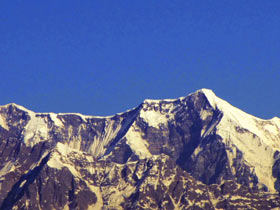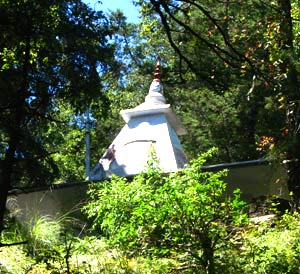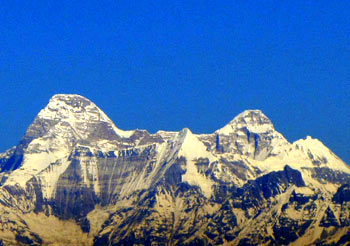|
Travelogues
Mukteshwar, Kumaon, Uttarakhand
|
|||||
Way back in the mid-80s, on a cold winter day, we first visited Mukteshwar from Almora, where we lived at the time. Riding on a Yezdi on a non-metalled road from Qwarav Pul near Almora, bundled in many layers, were 2 adults and a little boy, plus luggage. We were perforce acutely aware of the stones on the road. Yet we were more aware that the view of the Himalayas was spectacular. |
More on Uttarakhand • Nainital • Districts
Travelogues
Adventure
Pilgrim Trails | ||||
 We had stayed at the IVRI guest house. In the early evening, we had visited Mukteshwar Maharaj, who was at the time maintaining maun (silence). He started his conversation on a slate, later picking up the pen and paper I had at hand, writing in English, to facilitate my understanding, though I was sufficiently proficient in spoken and written Hindi and Bengali, both of which languages he also wrote and spoke. As the evening wore on, his hoarse whisper, in a rasping voice, conveyed even more. I reminded him of his maun. He dismissed it with total disregard. I realised a neophyte must maintain strict discipline. One who knows, moves as the wind. I will not forget the evening, ever.
We had stayed at the IVRI guest house. In the early evening, we had visited Mukteshwar Maharaj, who was at the time maintaining maun (silence). He started his conversation on a slate, later picking up the pen and paper I had at hand, writing in English, to facilitate my understanding, though I was sufficiently proficient in spoken and written Hindi and Bengali, both of which languages he also wrote and spoke. As the evening wore on, his hoarse whisper, in a rasping voice, conveyed even more. I reminded him of his maun. He dismissed it with total disregard. I realised a neophyte must maintain strict discipline. One who knows, moves as the wind. I will not forget the evening, ever. I visited Mukteshwar many times since. The first time is what has brought me back here, not to recreate a time long gone, not in reminiscence, but simply because my footsteps turned this way, again and again. The silence in the forests of oak and birch is only an invitation to listen to the sounds of the forest. The glorious sunsets bathe Nanda Devi, Trishul, some 20 peaks, in gold and crimson. The luminous moon shines through the trees. The constellations of stars twinkle -'how I wonder what you are, up above the world so high, like a diamond in the sky'.
Today, 16th Sept 2011, when I reached Mukteshwar, I heard that Mukteshwar Maharaj is living at the temple. I realised that the people here now have forgotten who he was, and his disciple, Swami Sanshudhanandji, has taken on the mantle."The old order changeth yielding place to new, and God fulfils himself in many ways." Mukteshwar, at 7,500 feet, is about 75 kms from Kathgodam, the railhead, where one leaves the hot, dusty plains behind. The town derived its name from a temple of Lord Shiva: Ishwar who grants mukti. Near here, Mukteshwar Maharaj had spent long years in sadhana and tapasya.
There is an old church at Mukteshwar. The PWD guest house offers stunning views of the peaks at sunrise and sunset. Here, Jim Corbett often stayed. This region is home to 18 species of mammals, nearly 200 species of birds, 15 kinds of fruit trees and more than 75 varieties of flowers. Chauthi Jali is a vertiginous outcrop of rocks. Here one can sit mesmerised by eagles as they glide, swoop, circle thermals. The government-run Kumaon Mandal Vikas Nigam runs its usual kind of outfit above the PWD. The KMVN guest houses are at some of the best locations. And there are no surprises there. They probably deserve a medal for being clones of one another. Several lodges and what-you-may-call-it's have mushroomed, to cater to the increasing popularity of off-beat tourist destinations.
Photo Credit: Rajiv Butalia
|
|||||
Editor: Romola Butalia (c) India Travelogue. All rights reserved. |
|||||

 Many years later, on impulse, I arrived here suddenly, alone, and realised this is one of the few places in the Himalayas I did not want to be alone, not because I felt un-nerved, but because there was too much I wanted to share here. I had walked up to the temple only to hear that Mukteshwar Maharaj was living in Kolkata. Later still, I learnt from a mutual friend, about his last days in his mortal body, and how he had taken Samadhi in his ashram at Kolkata.
Many years later, on impulse, I arrived here suddenly, alone, and realised this is one of the few places in the Himalayas I did not want to be alone, not because I felt un-nerved, but because there was too much I wanted to share here. I had walked up to the temple only to hear that Mukteshwar Maharaj was living in Kolkata. Later still, I learnt from a mutual friend, about his last days in his mortal body, and how he had taken Samadhi in his ashram at Kolkata.  Mukteshwar became 'known' because of the Indian Veterinary Research Institute which was established as a corollary to the Imperial Bacteriological Laboratory which shifted here from Pune in 1893.
Mukteshwar became 'known' because of the Indian Veterinary Research Institute which was established as a corollary to the Imperial Bacteriological Laboratory which shifted here from Pune in 1893. This region has become a hide-out for Delhi-ites seeking a refuge within reasonable driving distance of Delhi. The fall-out is that the indigenous culture and lifestyle is fast getting eroded as Kumaonis opt to sell out their ancestral land to descend to Haldwani for an easier lifestyle. The simple Kumaoni architecture that blended into the mountainscape, the terraced fields cultivated with toil and tears, the spontaneous warmth and hospitality of a deeply spiritual people who believed in 'high thinking and simple living' will likely soon be known only in sociological research papers. Instead, the wealth of city dwellers and the ethos of the plains will bring a lifestyle here that cannot be sustained in these fragile mountain regions that are the abode of the gods.
This region has become a hide-out for Delhi-ites seeking a refuge within reasonable driving distance of Delhi. The fall-out is that the indigenous culture and lifestyle is fast getting eroded as Kumaonis opt to sell out their ancestral land to descend to Haldwani for an easier lifestyle. The simple Kumaoni architecture that blended into the mountainscape, the terraced fields cultivated with toil and tears, the spontaneous warmth and hospitality of a deeply spiritual people who believed in 'high thinking and simple living' will likely soon be known only in sociological research papers. Instead, the wealth of city dwellers and the ethos of the plains will bring a lifestyle here that cannot be sustained in these fragile mountain regions that are the abode of the gods.